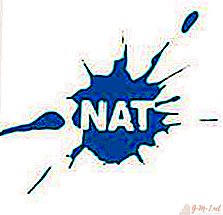Many users, having a router, think that it is needed only in order to connect to the Internet only they could. In fact, it also performs the function of connecting other users to the server. In this article we will tell you what NAT is in the router, what it is for and how to configure it.
NAT in the router - what is it?
Network Address Translation from English translates as "network address translation" - this is the process of translating internal addresses to external addresses. If this function is not configured, the router will block access to any ports to all incoming connections from the global Internet, while configured, it will allow it.
Customization
To configure nat on your own router, you must perform the following series of actions:
- Launch any browser on your computer and in the search bar type the address of this device 192.168.1.1 or 192.168.0.1.
- Then enter the login and password Admin / Admin. After, you can replace this username and password with your own.
- In the window that opens, select Settings - Network - Routing (routes) and click on the New rule, which allows you to set the routing conditions in any way. There are five ways: through a DNS name, through a port, through broadcasting to a specific user, through a network interface, or spoofing an address to a source address.
- Next, you need to set the traffic conditions, one of the four proposed options (Auto, Gateway, Trunk, Interface) and click "Next" and "Close".
After performing this series of actions, the router is ready to work.
There are times when you need to configure nat on your computer. To do this, through the "Start" should go to the "Control Panel" and run "Network Connections". Select a new network device and right-click on it, in the "Properties" select "Advanced". And check the boxes next to "Allow other network users to use this connection" and click OK.

Loopback setting
The meaning of the nat loopback loopback loop is that if a packet gets from the internal network to the external IP address of the router, it is considered to have come from outside - which means that the firewall rules related to external connections work. If the packet successfully passes through the firewall, then nat is triggered, which becomes an intermediary between two computers located on the same network.
Attention! Without the nat loopback function, it would be impossible to find out about the network service settings or go to the server. For each domain, it would be necessary to configure the hosts file manually.

Nat types
There are several types of Network Address Translation. Consider each of them in detail:
 Only companies use Static NAT, since they have many IP addresses that do not change and should always be accessible from the outside. For example, in order to open a site, you need to know its IP address and port, but since the port is always automatically entered by a special program, you only need to know the DNS name. User addresses are not visible on the Internet.
Only companies use Static NAT, since they have many IP addresses that do not change and should always be accessible from the outside. For example, in order to open a site, you need to know its IP address and port, but since the port is always automatically entered by a special program, you only need to know the DNS name. User addresses are not visible on the Internet.- Dynamic NAT When the user is on the Internet, the router itself selects only one among the received IP addresses, and then enters it into the nat table. This entry is immediately deleted as soon as the user logs out of the network.
- PAT or NAT Overload. This type is more suitable for users in the form of individuals. Since a single external address and two ports (internal and external) are issued, which are indicated by the users themselves. You can access this service only with the help of a certain program.
Important! Ports often need to be configured manually.
How to change type
 In order to change the type of NAT from one to another, you need to go to your router by entering the combination of 192.168.1.1 or 192.168.0.1. In the browser search line and enter your login and password. Then see your IP address and network settings of your device. Then you need to contact your Internet connection provider in order to reconfigure your router to the type you need. To do this, he will need to provide all the data.
In order to change the type of NAT from one to another, you need to go to your router by entering the combination of 192.168.1.1 or 192.168.0.1. In the browser search line and enter your login and password. Then see your IP address and network settings of your device. Then you need to contact your Internet connection provider in order to reconfigure your router to the type you need. To do this, he will need to provide all the data.

 Only companies use Static NAT, since they have many IP addresses that do not change and should always be accessible from the outside. For example, in order to open a site, you need to know its IP address and port, but since the port is always automatically entered by a special program, you only need to know the DNS name. User addresses are not visible on the Internet.
Only companies use Static NAT, since they have many IP addresses that do not change and should always be accessible from the outside. For example, in order to open a site, you need to know its IP address and port, but since the port is always automatically entered by a special program, you only need to know the DNS name. User addresses are not visible on the Internet.
Leave Your Comment